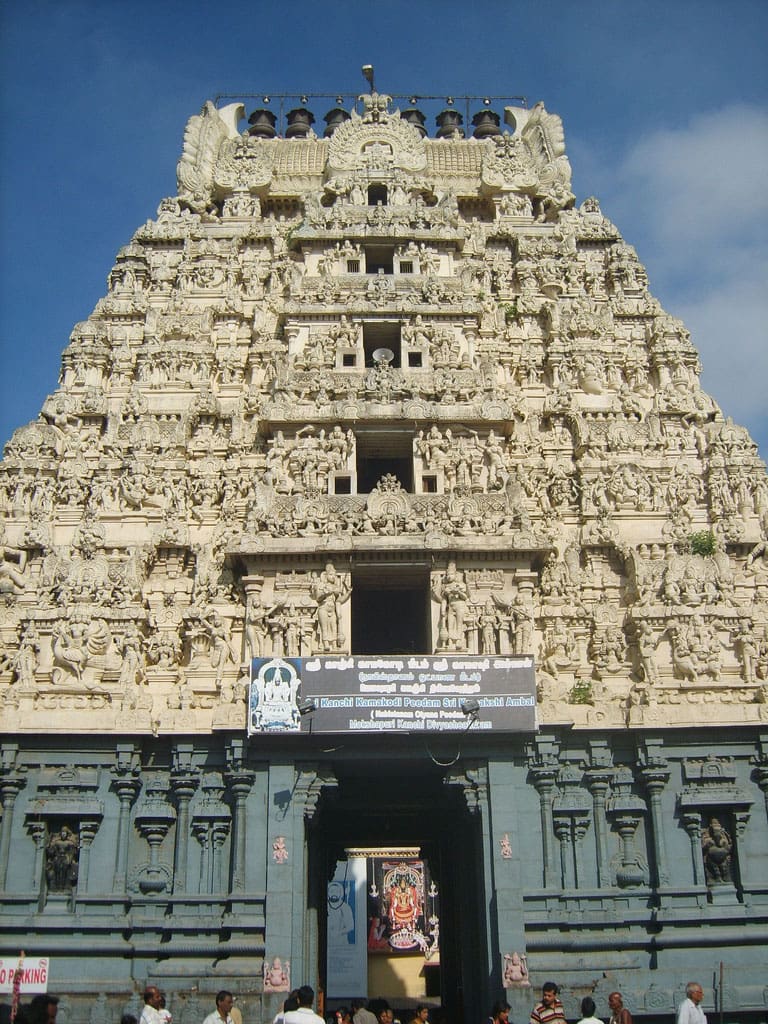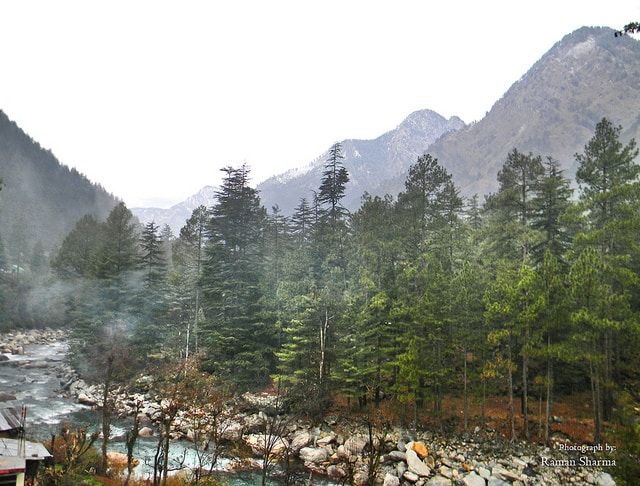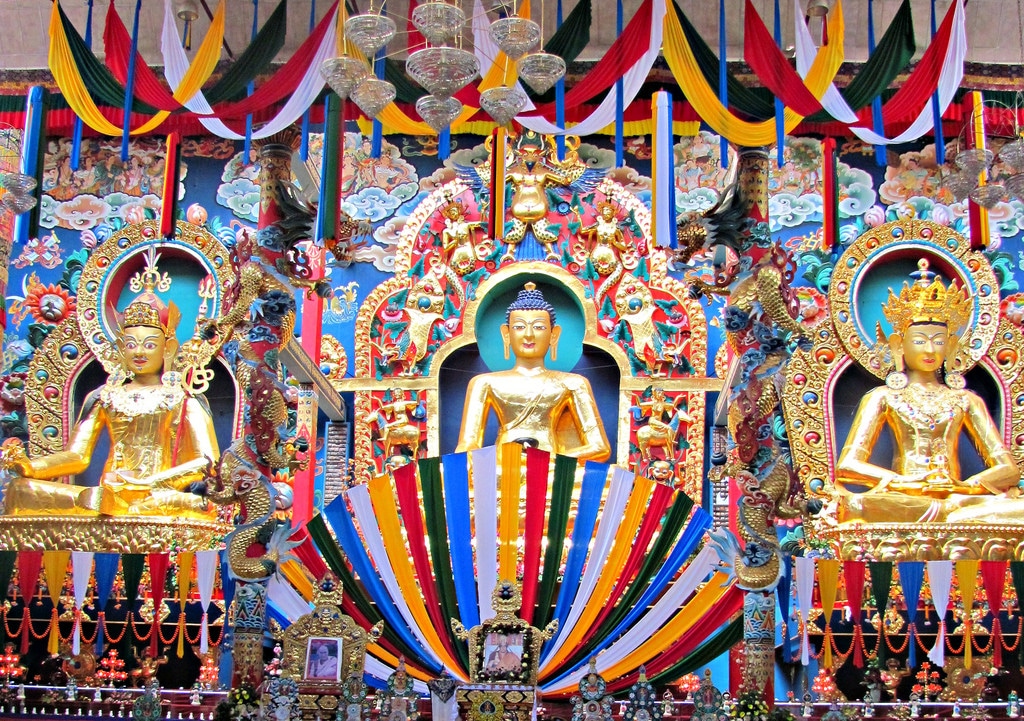Nestled in the heart of Kanchipuram, Tamil Nadu, the Kamakshi Amman Temple stands as a timeless beacon of spirituality, devotion, and architectural grandeur. Revered as one of the 51 Shakti Peethas, this ancient Hindu temple is dedicated to Goddess Kamakshi, a divine manifestation of Adi Parashakti, the supreme goddess in Shaktism. Kanchipuram, often called the “City of a Thousand Temples,” is a historic and cultural hub, and the Kamakshi Amman Temple serves as its spiritual epicenter. This comprehensive guide explores the temple’s rich history, intricate architecture, vibrant festivals, and profound spiritual significance, offering an immersive journey for devotees, historians, and travelers alike.
The Historical Significance of Kamakshi Amman Temple
The Kamakshi Amman Temple traces its origins to the Pallava dynasty, which ruled Kanchipuram from the 5th to 8th centuries CE. As the capital of the Pallavas, Kanchipuram flourished as a center of art, culture, and religion, with the temple emerging as a pivotal site of worship. Some historical accounts suggest contributions from the Chola dynasty in the 14th century, while local legends attribute later expansions to the Vijayanagara rulers. The temple’s enduring legacy is tied to its association with the Kanchi Kamakoti Peetham, a revered spiritual institution established by Adi Shankaracharya, the 8th-century philosopher and theologian.
The temple is believed to be one of the 51 Shakti Peethas, sacred sites where parts of Goddess Sati’s body are said to have fallen. According to legend, the navel of Sati fell at Kanchipuram, earning the temple the title of Nabhi Peetham or Odhyana Peetham. This sacred connection elevates the temple’s status, making it a must-visit pilgrimage site for devotees of Shaktism. The temple’s historical significance is further enriched by its mention in ancient Tamil Sangam literature, such as the Perunaraatrupadai, which praises the city and its spiritual heritage under the rule of King Thondaiman Ilandiraiyan.
Architectural Splendor of Kamakshi Amman Temple
The Kamakshi Amman Temple is a masterpiece of Dravidian architecture, sprawling across five acres and showcasing intricate carvings, towering gopurams, and serene temple tanks. The main entrance, known as the Raja Gopuram, is adorned with detailed sculptures depicting deities, mythological stories, and celestial beings. The temple’s gold-plated vimanam (tower) above the sanctum sanctorum gleams as a symbol of divine radiance, visible to devotees from a distance.
The Sanctum Sanctorum and Goddess Kamakshi
At the heart of the temple lies the sanctum sanctorum, where Goddess Kamakshi is enshrined in a majestic Padmasana (lotus) posture, symbolizing peace and prosperity. The idol, crafted from gold and silver, is adorned with vibrant saris, sparkling jewels, and fresh flowers. The goddess holds a sugarcane bow and lotus in her lower hands, with a pasha (lasso) and ankusha (goad) in her upper hands, while a parrot perches nearby, adding to the serene ambiance. A Chandraperai (crescent moon) adorns her forehead, signifying her divine grace.
The sanctum also houses the Sri Chakra, a sacred geometric yantra installed by Adi Shankaracharya to pacify the goddess’s fierce Ugra Swaroopini form and transform her into the tranquil Shanta Swaroopini. This Sri Chakra, covered with pink lotus flowers, is a focal point of worship, with daily rituals performed to honor its spiritual potency.
Shrines and Mandapas
The temple complex is a labyrinth of sacred spaces, including:
- Tapa Kamakshi Shrine: Located to the right of the main idol, this shrine depicts Goddess Kamakshi as a yogini in a balancing yoga pose, commemorating her penance under a mango tree to marry Lord Shiva as Ekambareswara.
- Anjana Kamakshi Shrine: Also known as Arupa Lakshmi, this shrine to the left of the main idol faces north and honors Lakshmi’s penance to regain her beauty, with offerings of kumkuma distributed to devotees.
- Tirukkalvanur Divya Desam: A shrine for Lord Vishnu in his Varaha form, reflecting the belief that Vishnu is Kamakshi’s brother. This shrine is one of the 108 Divya Desams, sacred Vaishnava sites.
- Hayagriva and Agastya Shrine: Located in the third enclosure, this shrine commemorates Sage Agastya’s learning of the Lalita Sahasranamam from Hayagriva, an avatar of Vishnu.
- Bila Gate and Bilakasha Tree: A sacred passage leading to the Bilakasha tree, associated with Kamakshi’s triumph over the demon Bhandasura, is a significant feature within the sanctum.
The temple’s mandapas (halls), such as the 100-pillared hall and the dwajaarohana mandapam, are adorned with intricate carvings and serve as spaces for rituals and gatherings. The temple tank, or pushkarini, adds to the serene ambiance, reflecting the architectural harmony of the complex.
Spiritual Significance of Kamakshi Amman Temple
The Kamakshi Amman Temple is a cornerstone of Shaktism, one of the three principal centers of Goddess worship in India, alongside the Meenakshi Temple in Madurai and the Visalakshi Temple in Varanasi. The name “Kamakshi” is derived from Sanskrit, where “Ka” represents Goddess Saraswati (knowledge), “Ma” signifies Goddess Lakshmi (wealth), and “Akshi” means eyes, symbolizing the goddess’s all-encompassing grace.
The Legend of Kamakshi and Bhandasura
According to mythology, the gods, tormented by the demon Bhandasura, sought refuge in Kanchipuram. They worshipped Adi Parashakti in the form of parrots perched on champaka trees. Pleased by their devotion, the goddess emerged through the Bila gate and vanquished Bhandasura, establishing her divine presence in the temple. This legend underscores Kamakshi’s role as a protector and nurturer, embodying both fierce and compassionate energies.
Adi Shankaracharya’s Legacy
Adi Shankaracharya’s contributions to the temple are profound. During his visit to Kanchipuram, he found the goddess in a fierce form, radiating intense energy. To calm her, he composed the Soundarya Lahari, a collection of hymns praising her beauty and grace, and installed the Sri Chakra to channel her divine energy. This act transformed Kamakshi into a serene deity, accessible to devotees seeking blessings for prosperity, knowledge, and spiritual liberation.
The temple is also the seat of the Kanchi Kamakoti Peetham, a monastic institution founded by Shankaracharya. The Jagadguru Shankaracharya Swamigal serves as the hereditary trustee, ensuring that rituals and festivals adhere to ancient traditions. The Peetham’s influence extends beyond the temple, making it a center for spiritual learning and cultural preservation.
Festivals and Rituals at Kamakshi Amman Temple
The Kamakshi Amman Temple is a vibrant hub of religious activity, with daily rituals and grand festivals that attract devotees from across the globe. The temple’s calendar is filled with events that celebrate the goddess’s divine presence and the city’s spiritual heritage.
Daily Rituals
The temple conducts four worship services daily, starting at 5:30 AM and concluding at 8:15 PM (extended to 9:30 PM on Fridays and 10:30 PM on Pournami days). The Abhishekam, a sacred bathing ritual of the deity, is a highlight, performed at 11:00 AM and 4:00 PM. Limited to 20 participants per session, the Abhishekam allows devotees to sit in the sanctum sanctorum, witnessing the goddess adorned with milk, sandalwood, and other offerings. Tickets, priced at ₹1,000 per person, are available at the temple’s counter.
Major Festivals
The temple hosts several festivals that showcase its cultural and spiritual vibrancy:
- Brahmotsavam (February-March): A 10-day festival in the Tamil month of Masi, featuring processions, rituals, and the silver chariot festival on the seventh day. The goddess is taken out in a grand procession, adorned with jewels and flowers.
- Navaratri (October): A nine-day celebration where Kamakshi is adorned in opulent attire, with each day dedicated to a different form of the goddess. The festival culminates in Vijayadashami, marked by vibrant processions and cultural performances.
- Aadi and Aippasi Pooram: These festivals honor the goddess with special pujas and processions, drawing large crowds of devotees.
- Sankara Jayanthi: Commemorating Adi Shankaracharya’s birth, this festival includes recitations of his hymns and spiritual discourses.
- Vasanta Utsavam (June-July): A spring festival celebrating renewal and devotion, with the goddess taken out in a golden chariot on Fridays at 7:00 PM.
- Swarna Rathotsavam: A spectacular event where Kamakshi is paraded in a golden chariot, symbolizing her divine journey through Kanchipuram.
These festivals transform the temple into a kaleidoscope of colors, music, and devotion, offering visitors a glimpse into Tamil Nadu’s rich cultural tapestry.
Exploring the Kamakshi Amman Temple Complex
The temple’s sprawling layout invites exploration, with each corner revealing a new facet of its spiritual and architectural heritage. Visitors can navigate the complex through its four entrances, each marked by a towering gopuram. The main entrance on the eastern side leads to the sanctum, while the other entrances offer access to additional shrines and mandapas.
Key Features to Explore
- Raja Gopuram: The main entrance, adorned with intricate carvings, serves as a gateway to the divine. Its towering presence is a testament to Dravidian architectural prowess.
- Temple Tank (Pushkarini): A serene body of water used for ritual bathing, reflecting the temple’s golden vimanam and adding to the tranquil ambiance.
- 100-Pillared Hall: A magnificent hall with intricately carved pillars, used for rituals and gatherings, showcasing the temple’s artistic heritage.
- Sri Chakra: Located in front of the main idol, this sacred yantra is a focal point for meditation and worship, symbolizing the goddess’s cosmic energy.
- Silver Pillar: A unique feature in the sanctum, with a hole representing the navel, where childless couples pray for blessings.
Practical Tips for Visitors
- Dress Code: Adhere to conservative clothing, such as sarees, dhotis, or formal attire. Avoid shorts, sleeveless tops, or revealing outfits.
- Photography: Photography is restricted inside the sanctum sanctorum but permitted in the outer areas. Respect temple guidelines and avoid disturbing rituals.
- Timing: Visit early in the morning (5:30 AM–12:15 PM) to avoid crowds, or during the evening Abhishekam (4:00 PM) for a more immersive experience.
- Accessibility: The temple is accessible for differently-abled visitors, with ramps and assistance available upon request.
Kanchipuram: The City of Temples
Kanchipuram, known as “Nagareshu Kanchi” (the best among cities) by the poet Kalidasa, is a living museum of India’s spiritual and cultural legacy. As one of the seven Mokshapuris (sacred cities offering salvation), it is home to numerous temples, each with its own historical and spiritual significance.
Nearby Temples to Visit
- Ekambareswarar Temple: Dedicated to Lord Shiva, this temple represents the earth element among the Pancha Bhoota Sthalams. Its 40-acre complex and towering gopuram are architectural marvels.
- Varadharaja Perumal Temple: A key Vaishnava site, this temple is one of the 108 Divya Desams, famous for its 40-foot reclining idol of Lord Athi Varadaraja, displayed once every 40 years.
- Kailasanathar Temple: The oldest temple in Kanchipuram, built by the Pallavas, featuring a 16-sided Shiva Linga and a secret tunnel used by royalty during wars.
- Adhi Kamakshi Amman Temple: A smaller, serene temple dedicated to Mother Adi Kamakshi, offering a peaceful contrast to the bustling main temple.
Kanchipuram’s Silk Weaving Tradition
Beyond its spiritual allure, Kanchipuram is renowned for its silk sarees, known as Kanjeevaram sarees. These exquisite textiles, woven by skilled artisans, are a hallmark of South Indian weddings. Visitors can explore weaving centers on Gandhi Road or Mettu Street to witness the craftsmanship and purchase authentic sarees as souvenirs.
How to Reach Kamakshi Amman Temple
Kanchipuram is well-connected to major cities, making the Kamakshi Amman Temple easily accessible for pilgrims and tourists.
- By Air: Chennai International Airport, 70 km away, is the nearest airport, with regular flights from Delhi, Mumbai, Bangalore, and other cities. Taxis and buses from Chennai to Kanchipuram take approximately 1.5–2 hours.
- By Train: Kanchipuram Railway Station, 3 km from the temple, is connected to Chennai Central via suburban trains. A journey from Chennai to Kanchipuram via Tambaram takes about 2.5–3 hours and costs ₹50–₹100.
- By Road: Kanchipuram is accessible via NH48 from Chennai and Bangalore. State-run buses and private taxis are available, with travel times of 1.5–2 hours from Chennai and 5–6 hours from Bangalore.
- Local Transport: Auto-rickshaws, cycle rickshaws, and taxis are available within Kanchipuram for short distances. The temple is centrally located, making it walkable from nearby accommodations.
Best Time to Visit Kamakshi Amman Temple
The ideal time to visit the Kamakshi Amman Temple is between October and March, when the weather is pleasant, with temperatures ranging from 20°C to 30°C. This period coincides with major festivals like Navaratri and Brahmotsavam, offering a vibrant cultural experience. Summers (April–June) can be hot, with temperatures reaching 40°C, while the monsoon season (July–September) brings moderate rainfall, which may affect outdoor exploration.
Accommodation Near Kamakshi Amman Temple
Kanchipuram offers a range of accommodations to suit various budgets, from budget guesthouses to mid-range hotels. Some recommended options include:
- Sree Sakthi Residency: Located close to the temple, this hotel offers clean, spacious rooms ideal for early morning darshan.
- MM Hotel: A mid-range option with modern amenities, including air-conditioned rooms and a restaurant.
- Hotel Tamilnadu: A government-run hotel offering comfortable stays and proximity to major temples.
- Yatri Nivas: A budget-friendly guesthouse catering to pilgrims, with basic amenities and easy temple access.
- GRT Regency: A premium hotel with luxurious rooms, dining options, and excellent service, located slightly farther from the temple.
Booking in advance is advisable during festival seasons, as accommodations fill up quickly.
Cultural and Spiritual Experiences
Visiting the Kamakshi Amman Temple is not just a religious journey but a cultural immersion. The temple’s vibrant atmosphere, filled with the chants of priests, the fragrance of incense, and the sight of devotees offering prayers, creates a profound spiritual experience. Devotees can participate in special pujas, such as the Abhishekam or Archana, to seek blessings for prosperity, health, and spiritual growth.
The temple’s connection to Adi Shankaracharya and the Kanchi Kamakoti Peetham makes it a hub for spiritual learning. Visitors can attend discourses or explore the Peetham’s library, which houses ancient texts and manuscripts. The temple’s music and dance performances during festivals, inspired by traditional Carnatic music and Bharatanatyam, add to the cultural richness.
Travel Tips for Visiting Kamakshi Amman Temple
- Arrive early in the morning to avoid crowds and experience the serene ambiance of the temple.
- Purchase Abhishekam tickets at the temple counter early, especially during festivals, as slots are limited.
- Respect the dress code and remove footwear before entering the temple premises.
- Carry a reusable water bottle and stay hydrated, especially during summer visits.
- Explore nearby temples and silk weaving centers to make the most of your trip to Kanchipuram.
- Hire a local guide for a deeper understanding of the temple’s history and architecture.
- Avoid visiting during peak summer months (April–June) due to high temperatures.
- Check the temple’s official website or Facebook page for updates on festival schedules and live telecasts.
15 FAQs About Kamakshi Amman Temple
- What is the significance of Kamakshi Amman Temple?
The temple is one of the 51 Shakti Peethas, believed to be the site where the navel of Goddess Sati fell. It is a major center of Shaktism, dedicated to Goddess Kamakshi, an incarnation of Parvati. - What are the temple’s opening hours?
The temple is open from 5:30 AM to 12:15 PM and 4:00 PM to 8:15 PM, with extended hours on Fridays (9:30 PM) and Pournami days (10:30 PM). - Is there an entry fee for the temple?
Entry to the temple is free, but special rituals like Abhishekam cost ₹1,000 per person. - How can I book Abhishekam tickets?
Tickets are available at the temple’s counter. There is no official online booking system, so arrive early, especially on festival days. - What is the dress code for visitors?
Conservative attire is required, such as sarees, dhotis, or formal clothing. Avoid shorts, sleeveless tops, or revealing outfits. - Can non-Hindus visit the temple?
Non-Hindus are welcome to explore the temple complex but may be restricted from entering the sanctum sanctorum. - What are the major festivals celebrated at the temple?
Key festivals include Brahmotsavam, Navaratri, Aadi and Aippasi Pooram, Sankara Jayanthi, and Vasanta Utsavam. - How do I reach Kamakshi Amman Temple from Chennai?
Take a suburban train from Chennai Central to Tambaram, then a direct train to Kanchipuram (2.5–3 hours, ₹50–₹100). Alternatively, drive or take a bus (1.5–2 hours). - What is the best time to visit the temple?
October to March offers pleasant weather and coincides with major festivals like Navaratri and Brahmotsavam. - Are there accommodations near the temple?
Yes, options include Sree Sakthi Residency, MM Hotel, Hotel Tamilnadu, and GRT Regency, catering to various budgets. - Is photography allowed inside the temple?
Photography is restricted in the sanctum sanctorum but permitted in the outer areas. - What is the Sri Chakra, and why is it significant?
The Sri Chakra is a sacred yantra installed by Adi Shankaracharya to channel the goddess’s energy. It is a focal point for worship and meditation. - What other temples can I visit in Kanchipuram?
Nearby temples include Ekambareswarar Temple, Varadharaja Perumal Temple, Kailasanathar Temple, and Adhi Kamakshi Amman Temple. - Can I participate in temple rituals?
Yes, devotees can participate in rituals like Abhishekam and Archana by purchasing tickets or registering at the temple counter. - What is the Kanchi Kamakoti Peetham?
It is a monastic institution founded by Adi Shankaracharya, responsible for managing the temple’s rituals and preserving its spiritual legacy.























